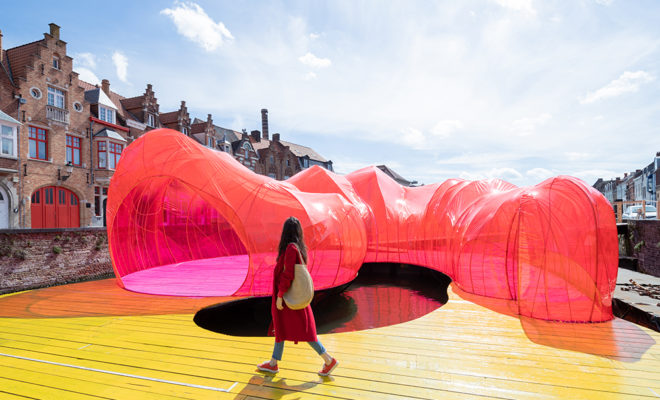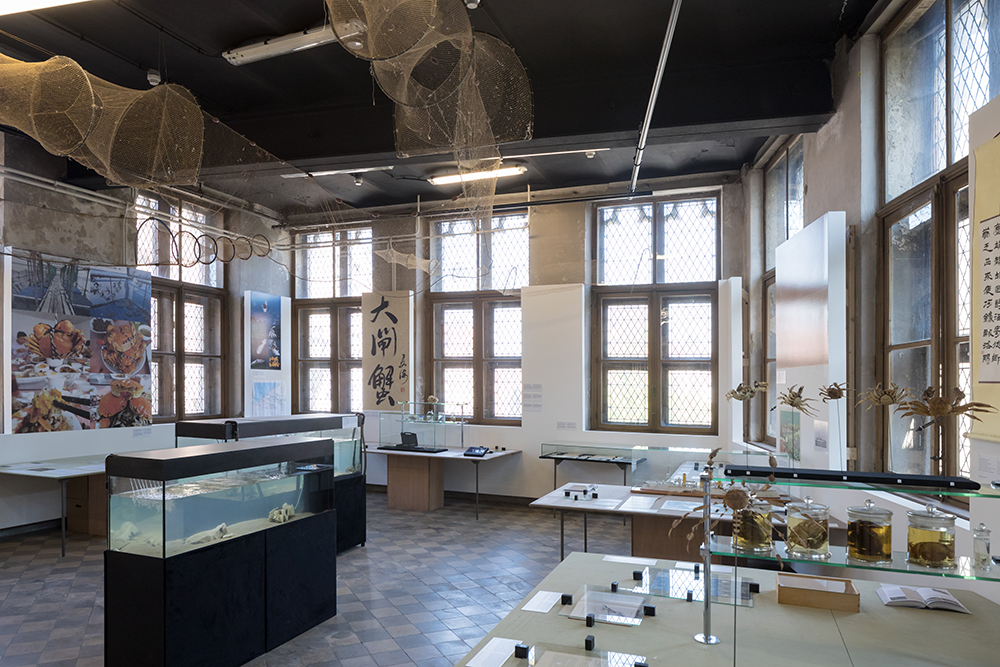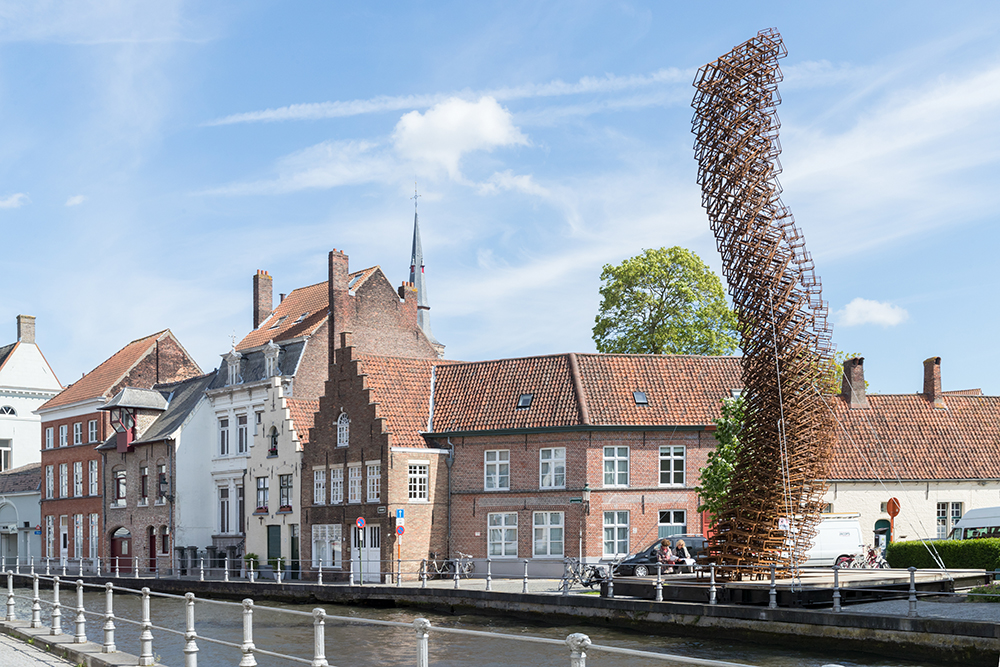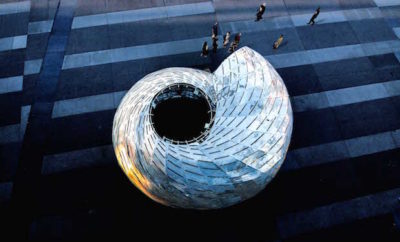 All photography by Iwan Baan, courtesy of Bruges Triennial.
All photography by Iwan Baan, courtesy of Bruges Triennial.
Design
At the Bruges Triennial, Contemporary Art Mingles with Monuments to the Past
Once home to Flemish masters, Bruges, the picturesque city with a storied and well-preserved past—one it can sometimes seem a tad stuck in—has invited contemporary design onto its canals and plazas this summer as part of the Bruges Triennial.
Brigadoonian as it looks, Bruges is no less immune to the challenges of today than the rest of Europe is. For one, the city is beset by staggering (over)tourism—Bruges plays host to 9 million visitors a year, nearly equal to the population of Belgium. It’s enough to make Bruggelings pine for an idealized past of which they have no memory but that’s inscribed in the very stones of their medieval homes. For Mayor Renaat Landuyt, the former minister of employment and tourism in Flanders, it’s important that Bruges “go[es] with the flow.” The Bruges Triennial, which is heir to a tradition of Belgian art festivals that ended more than forty-five years ago, features contemporary art and architectural interventions in the frozen heart of the city and addresses the difficulties a “museum city” faces in the twenty-first century. The 2015 edition, the first in the rejuvenated series, took as its theme a question with real bite—“What if the visitors to the city all suddenly decided to stay?”—and this year’s festival, dubbed Liquid City, tackles sociologist and philosopher Zygmant Bauman’s concept of “liquid ,” where “precariousness, instability, [and] vulnerability [are] the most widespread . . . feature[s] of contemporary life.”

MFS III – Minne Floating School by NLÉ, 2018.
As triennial co-curator Michel Dewilde puts it, the challenge for Liquid City’s organizers was “to look beyond the chaos and uncertainty embodied by the liquid condition and hope that the liquid can inspire . . . positive changes.” Interestingly, of the fifteen artists, architecture firms, and design collectives invited to contribute works, many sidestepped the local dilemma of over-tourism to address a global issue: climate change.
MFS III – Minne Floating School by Nigerian collective NLÉ is the first project visitors see when approaching Bruges from the south—the city’s main entrance. NLÉ’s conception of a sustainable, alternative building system first took shape in Nigeria, on the outskirts of a slum, rising partially on stilts from the Lagos Lagoon like a human mangrove forest. The city of Lagos is so short on space for its 7-million-plus inhabitants that members of the Makoko-Iwaya Waterfront community have been forced to adopt an amphibious lifestyle. The slum is a grim portent for what’s to come for many low-lying coastal cities. While NLÉ’s prototype school was undone by a zephyr in 2016 after years of deferred maintenance, a solar-panel-bedecked upgrade now bobs on Bruges’s tranquil Lake of Love, guarded by a flotilla of bad-tempered swans and giving hope to land-bound pedagogues everywhere.

Who’s Eating the Chinese Mitten Crab? by Rotor, 2018.
Dewilde approves of the environmental stance adopted by triennial participants. “It is time to review the highpoint of human culture, the city, [and] to set it in the middle of nature,” he says. One method for doing this is demonstrated in Zeebrugge, Bruges’s modern-day port, where humans are being re-inserted into the natural food chain. At URB SEA pop-up café the invasive Chinese Mitten Crabs are what’s for dinner. A concept dining experience ginned up by Brussels design collective Rotor titled Who’s Eating the Chinese Mitten Crab? turns triennial attendees into the canal-dwelling crabs’ “natural predators.” It’s a clever way of controlling the population of this unwelcome visitor and formed a nice complement to the city’s annual sustainable-food festival, (H)eerlijk Brugge in May. Rotor also serves up a side dish of models, archive material, objects, and aquariums full of crabs in Bruges’s historic Poortersloge.

Lanchal by John Powers, 2018.
Crabs aren’t the only creatures to be found frolicking in the canals this summer. To the delight of bathers, Spanish architecture duo Selgascano—well-known for its tent-like, brightly-colored blobitecture—is providing access to the Coupure canal via the vibrant red and yellow swimming platform Selgascano Pavilion. The pair wanted to brighten-up the rather droll Coupure, a waterway partitioned by locks and dams and surveyed by a prominent smokestack, that was only recently made safe for swimming more than forty years after residents last dove into what was sooty, polluted water.

Skyscraper (the Bruges Whale) by STUDIOKCA, 2018.
An enormous sculpture of a breaching blue whale is probably the most memorable work on view. Called Skyscraper (the Bruges Whale), it’s by Brooklyn duo STUDIOKCA, whose Orbit Pavilion, installed at the Huntington Library, Art Collection, and Botanical Gardens in San Marino, was covered in the pages of MODERN last year. The massive mammal has pride of place next to the square Jan van Eyck Plein and is armored with plastic waste—box fans, boots, barrels, gallon jugs, trash cans—emblazoned with Chinese characters and English words, all of it collected from the beaches of Hawaii. Like a golem constituted not from mud but from what’s known as the “plastic soup” floating on the world’s oceans, it looks ready to wreak havoc.
By inserting itself into the international discussion on climate change, Bruges certainly demonstrates one way for a city so attached to its past to embrace the twenty-first century. Once described as a “sleeping princess,” this summer the usually sedate and straitlaced Bruges is done up like a queen, dressed in vinyl and ready to go dancing. Take a whirl with her before it’s too late—things go back to normal on September 16.










